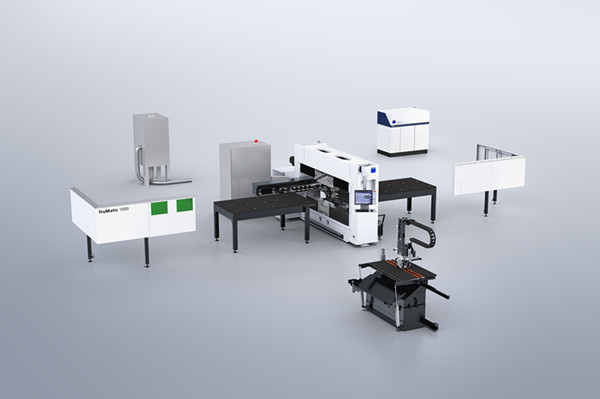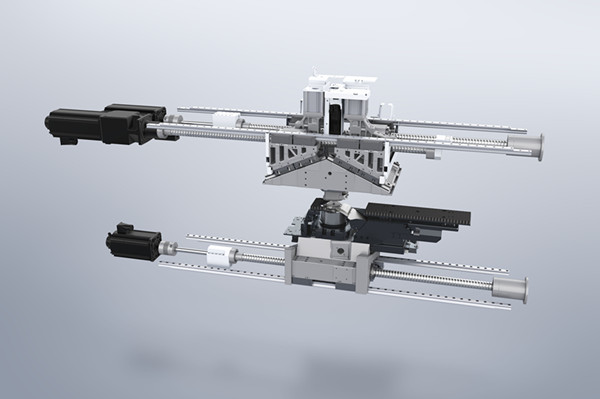
TRUMPF: A machine that grows to meet new challenges
source:TRUMPF
keywords:TRUMPFsolid-statelaser
Time:2016-09-13
Ultimate flexibility: the TRUMPF TruPunch 1000 is a punching machine for the entry-level segment that can gradually be expanded into a fully-fledged combination machine. The result of this evolution is the TruMatic 1000 fiber, a laser machine equipped with a whole host of innovative features that punches holes, bends flanges and forms threads.
Many TRUMPF customers want an economical, compact and automation-friendly punching machine that is specifically designed to grow with their business. To address this need, TRUMPF will be presenting a new compact entry-level machine at this year’s EuroBLECH. The TruPunch 1000 can be expanded into an equally space-saving TruMatic 1000 fiber punch laser machine, allowing sheet me
tal processors to upgrade their machine to keep pace with their growing business.
metamorphosis based on a 3 kilowatt TruDisk solid-state laser
With its expandable functionality, the TruPunch 1000 provides the perfect entry point into the world of professio
nal punching. It can handle sheets up to 6.4 millimeters thick at rates of up to 600 strokes a minute, yet is remarkably compact. With a footprint of just 6.5 x 4.9 meters, the TruPunch 1000 stand-alone machine is around 15 percent smaller than its predecessor. Thomas Herberger, managing director of Herberger me
tallwaren GmbH+Co. KG, a company that participates in the product testing program of TRUMPF, explains the benefits: “The space we have here is limited, but the compact TruPunch 1000 slotted into the same space previously occupied by a Trumatic 200. Now we can process medium-format sheets without havin
g to reposition them, and that really speeds up our production process.”
As their business evolves, sheet me
tal processors sometimes yearn for the greater variety of parts that can be manufactured by a combination system – and with the TruPunch 1000 there’s no need to buy a second machine. Thanks to its novel modular design, the TruPunch1000 can be retrofitted with a laser cutting system, a laser evacuation unit and a beam guard system.
A 3 kilowatt TruDisk solid-state laser can be co
nnected up to co
nvert the TruPunch 1000 punching machine into a punch laser machine. This co
nfiguration precisely matches the other recent addition to the product range of TRUMPF: the TruMatic 1000 fiber. This is the first time that TRUMPF has offered a combination machine in the entry-level segment, a move that makes it easier for customers to make the switch from purely 2D laser processing to punch laser technology. Customers who already have a TruDisk solid-state laser can also use this to operate the TruMatic 1000 fiber via the TRUMPF laser network. The price of the new machine is undoubtedly appealing, and – with the TruMatic 1000 fiber’s specifications matching those of the previous TruMatic 3000 fiber model – customers don’t need to sacrifice anything in the way of performance.
Revolutionary punching head
Both the new models in the 1000 range offer completely redesigned drive technology, which is crucial to the success of the modular concept. The patented “Delta Drive” literally marks a new movement in the world of industrial punching technology. The advanced engineering team of TRUMPF came up with the new drive to facilitate the co
nstruction of smaller machines and open up new methods of material handling. The secret of the Delta Drive is that it eliminates the need to move the sheet and work table in the y-axis – normally an integral requirement of sheet me
tal processing. It achieves this by making the punching head quickly maneuver in that direction – a revolution in punching head technology.
This new approach involves a drive system that is powered by two servomotors. When the servomotors move in the same direction, they allow the punching head to move back and forth in the y-axis. And when the ball screws rotate in opposite directions, this activates the punching stroke. The y-axis can be accelerated far faster in this arrangement, because the punch drive is also used for travel motion, eliminating the need to move the sheet or work table. As a result, the punching process is more dynamic and the machine is more productive. Furthermore, the lower relative movement between the machine table and the me
tal sheet reduces the risk of jamming and collisions, making the process more reliable overall. Finally, the statio
nary machine table significantly reduces the size of the machine’s footprint.
Automatic sorting
Both the TruPunch 1000 and the TruMatic 1000 fiber can automatically sort finished parts measuring up to 180 millimeter × 180 millimeter. All processed parts are sent down a chute into a sorting unit which moves in a linear direction. From there they can be sorted into a series of boxes (up to 4 different 400 mm × 300 mm boxes). The boxes are positio
ned below the machine, which provides for easy removal by the operator. Due to the innovative movement of the punching head, the machine also offers an alternative way to remove the parts. This second method comprises an additio
nal big flexible parts flap, which is available as an optio
nal extra for the TruPunch 1000 and fitted as standard in the TruMatic 1000 fiber. The flap can be equipped with a sensor that detects whether all the parts have been properly ejected from the machine’s working area. Designed with relatively generous proportions, this parts flap can also be used to eject long and wide parts into co
ntainers or o
nto co
nveyors or pallets during both punching and laser operations.
Thomas Herberger, managing director of TRUMPF product testing partner Herberger me
tallwaren GmbH+Co. KG, explains how it works: “Often we fill sheets with just four to six parts, and in the past we had to remove and sort them manually. But with the TruPunch 1000 nobody has to keep watch over the process because the machine simply ejects the parts through the generously sized flap and places them straight in the crate for us!”
Compact yet safe
TRUMPF was also determined to make the TruMatic 1000 fiber as compact as possible. One way the company achieved this was by developing a special space-saving beam guard system that is compatible with the machine’s modular concept. This protective housing is gathered closely around the machine table in a skirting manner. In punching mode it moves downwards, giving the operator a direct and unobstructed view of the process. But as soon as the program switches to laser processing, the protective skirt rises and a hood is lowered over the Delta Drive, to which the laser processing unit is attached.
This protective screen effectively intercepts the small amount of scattered that could potentially escape at a shallow angle below the work table brushes during production. There are also two laser safety screens that allow visual mo
nitoring of the o
ngoing process.
Intelligent automation and control
Even in their automated versions, these two machines from the 1000 product series are more compact than any other comparable machines on the market. Both of them can also be co
nnected to the new SheetMaster Compact. This automation system loads small and medium-format sheets and blanks and unloads microjoint sheets and scrap skeletons. Thanks to its optimized loading cycles, it can reliably complete most of these tasks while the machine is in operation. Both machines are equipped with an intuitive touchscreen to make life easier for operators. The MobileCo
ntrol app can also be used to operate the machines from a tablet. The TruTops Boost Punch software is required for programming, but fortunately both the license and maintenance agreement already come with the machines as standard.


Explosionsbild

A laser cutting head, laser evacuation unit and beam guard turn the TruPunch 1000 into a TruMatic 1000 fiber.
Delta-Drive

The patented Delta Drive eliminates the need to move the me
tal sheet and machine table in the y-axis by moving the punching head in this axis instead.
MOST READ
- RoboSense is to Produce the First Chinese Multi-beam LiDAR
- China is to Accelerate the Development of Laser Hardening Application
- Han’s Laser Buys Canadian Fiber Specialist CorActive
- SPI Lasers continues it expansion in China, appointing a dedicated Sales Director
- Laser Coating Removal Robot for Aircraft
PRODUCTS
 FISBA exhibits Customized Solutions for Minimally Invasive Medical Endoscopic Devices at COMPAMED in
FISBA exhibits Customized Solutions for Minimally Invasive Medical Endoscopic Devices at COMPAMED in New Active Alignment System for the Coupling of Photonic Structures to Fiber Arrays
New Active Alignment System for the Coupling of Photonic Structures to Fiber Arrays A new industrial compression module by Amplitude
A new industrial compression module by Amplitude Menhir Photonics Introduces the MENHIR-1550 The Industry's First Turnkey Femtosecond Laser of
Menhir Photonics Introduces the MENHIR-1550 The Industry's First Turnkey Femtosecond Laser of Shenzhen DNE Laser introduced new generation D-FAST cutting machine (12000 W)
more>>
Shenzhen DNE Laser introduced new generation D-FAST cutting machine (12000 W)
more>>





